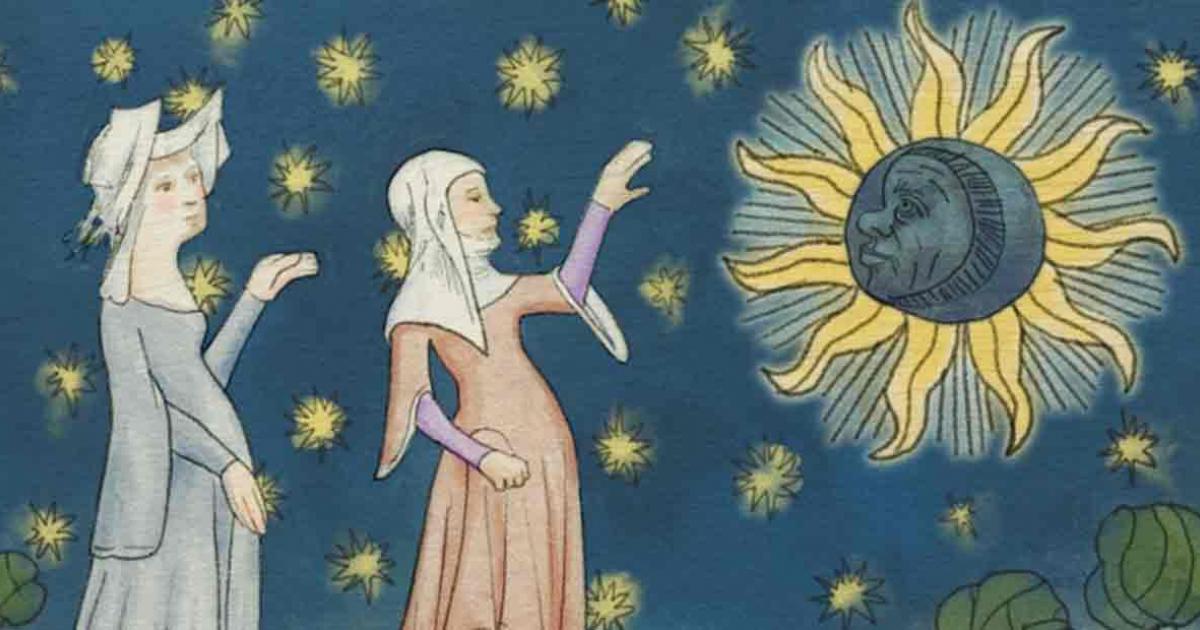
Surprising Facts and Beliefs About Eclipses from the Medieval and Renaissance Eras
By Sandra Knispel/University of Rochester
In medieval and Renaissance society and culture, celestial events were not mere spectacles in the sky. Rather, they were omens, predictors of the future, and windows into the workings of the universe.
University of Rochester historian Laura Ackerman Smoller and librarian Anna Siebach-Larsen, director of the Rossell Hope Robbins Library, shed light on how the people of the (falsely labeled) "Dark Ages" actually understood, interpreted, and experienced eclipses, planetary conjunctions, and other astronomical phenomena.
Eclipses were well understood in medieval Europe—at least mathematically
Forget the idea of flat earthers and the notion that medieval people "were generally stupid, ignorant, and superstitious," says Smoller, a professor of history at Rochester and a fellow of the Medieval Academy of America. Ancient and medieval astronomers "knew quite well how to predict when conjunctions and eclipses were going to happen," she says.
- The Life and Death Power of Eclipses in the Ancient World
- Ancient Myths and Legends Served to Explain the Startling Phenomenon of Solar Eclipse
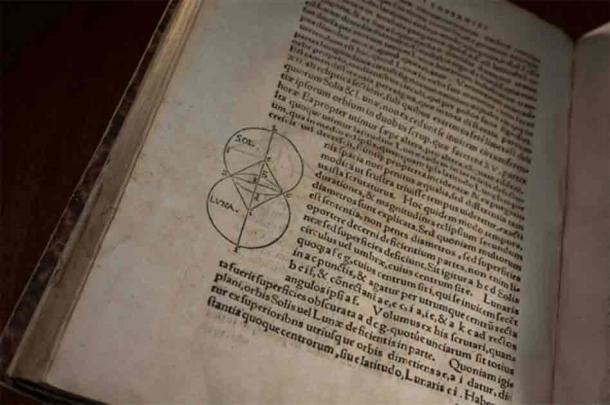
OFF-CENTER: First printed in 1543, De revolutionibus orbium coelestium (On the Revolutions of the Heavenly Spheres) by Renaissance astronomer and mathematician Nicolaus Copernicus posited a heliocentric model of the universe as an alternative to the then-widely accepted Earth-centric one. The University’s copy of the book dates to 1566. (University of Rochester photo / J. Adam Fenster)
They understood that if the Moon was either new or full, and when its path crossed the ecliptic—the Sun's path—you had an eclipse (a solar eclipse with the new moon and a lunar eclipse with the full moon). During an eclipse, the Sun and Moon are either in opposition (180 degrees opposite each other) or in conjunction in the exact same degree. But their paths have to be on the exact same plane and need to have crossed, explains Smoller. "That's mathematically pretty sophisticated to conceive," she says.
That said, medieval Europe still held a strictly Earth-centric view that considered the Sun and the Moon to be planets that orbit Earth—along with the five then-known planets Venus, Mercury, Mars, Jupiter, and Saturn. This geocentric model was not just specific to the Middle Ages—indeed, it was the predominant model in several classical civilizations, including ancient Greece and Rome.
In 1543, the publication De revolutionibus orbium coelestium (On the Revolutions of the Heavenly Spheres) by Renaissance astronomer and mathematician Nicholas Copernicus would kick off the Copernican Revolution. His work ultimately led to the long-held Earth-centric's model being replaced with a heliocentric one that has the Sun at the center of our solar system.
Celestial events like eclipses were used to predict the future, including the weather
Medieval Europeans saw alignments of planets, like conjunctions of Jupiter and Saturn, as signs of things to come—from famines, earthquakes, and floods, to the birth of Christ, and even the ultimate collapse of empires. They believed that eclipses, especially solar eclipses, could amplify and strengthen the effects of these planetary conjunctions.
The University's Department of Rare Books, Special Collections, and Preservation (RBSCP) is home to an early printed book from 1485 by Firmin de Beauval titled Opusculum repertorii prognosticon in mutationes aeris (On Predicting Changes in the Weather), published by Erhard Ratdolt, who specialized in printing works of geometry, astrology, and astronomy.

THE FINE PRINT: According to the text, when a solar eclipse is combined with the planetary conjunction of Saturn and Jupiter in the head of Aries, “the effects will last 12,000 years.” Note the faded marks near that passage in the lower right-hand margins—likely supplied by an early reader noting the super-booster effect. (Photo by Laura Ackerman Smoller)
A compilation of ancient medieval sources, the treatise deals with the influence of planets on meteorological phenomena and weather forecasting. But it also covers solstices and equinoxes, planetary conjunctions, and eclipses—and their reported ability to prognosticate the future.
Reading the original imprint (or incunable) in Latin, Smoller notes that eclipses were considered to boost the effects of planetary conjunctions. According to the text, when a solar eclipse is combined with the planetary conjunction of Saturn and Jupiter in the head of Aries, "the effects will last 12,000 years." That staggering number is not a typo. Smoller points to faded marks in the right margins that an early reader, likewise astonished at the described super-booster effect, made in the same passage.
Smoller pushes back against the conventional notion of the superstitious Middle Ages. "I don't think it's superstitious on their part to believe that things that happen in the heavens have an effect on Earth," she says, pointing to the example of tidal changes that are synched with the moon cycle. "That is the nature of medieval, ancient, and a lot of early modern natural philosophy, including beliefs held by Galileo and Kepler."
Medieval theologians pondered the meaning of the 'miraculous eclipse' that apparently occurred during Jesus's crucifixion
The study of eclipses was, unsurprisingly, essential for specialized astronomers. But it also formed part of a general university education during the Middle Ages, including for theologians.
Take the example of William of Auvergne, the bishop of Paris from 1228 to 1249 and a prominent theology professor at the University of Paris. William is one of many writers to discuss the purported "miraculous eclipse" that occurred at the time of Jesus's Crucifixion.
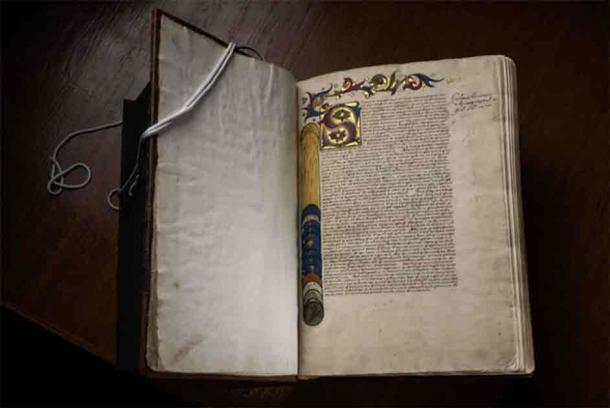
TIME CHECK: The University’s copy of De universo by William of Auvergne, a 13th-century theologian. Among other Christian writers, William insisted that the eclipse at the time of the Crucifixion had to be miraculous since such an event was not naturally possible given the timing. (University of Rochester photo / J. Adam Fenster)
With the 600-folio De universo, which translates to "On the universe," Williams provides "an extraordinary look at the culture of scientific thought and the ways in which it was transmitted," explained Siebach-Larsen after the University acquired a rare copy. The manuscript boasts an unusual illumination that is broken into four elements: earth (complete with mountains and trees), water (with fish), air (with flies), and fire. (Want to take a deeper dive into the De universo manuscript? Take a “guided tour” with Siebach-Larsen.)
An early witness to the idea of "natural magic" among medieval thinkers, William covers the topic of eclipses in De universo. He counts among the many Christian writers, beginning with the earliest Church fathers, to insist that the eclipse at the time of the Crucifixion had to have been miraculous, as it was not naturally possible, says Smoller. Why? Timing is everything: The Crucifixion reportedly took place during Passover, which begins on the first or second full moon after the spring equinox. But you need a new moon—not a full moon—for a solar eclipse to occur.
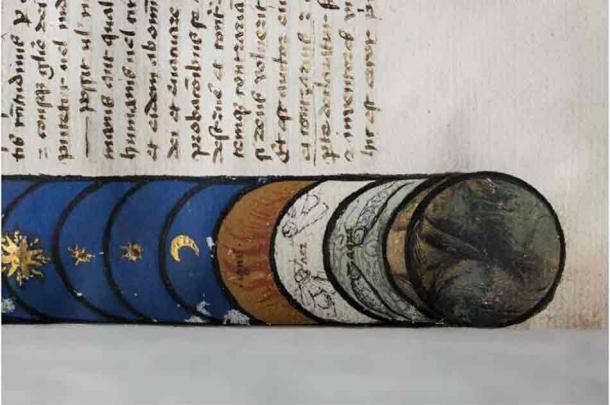
The first page of De universo features a remarkably detailed illumination depicting the four elements of nature (from right): earth, water (note the pair of fish), air (complete with flies), and fire. (University of Rochester photo / J. Adam Fenster)
Doctors in the Middle Ages needed to know about eclipses, too
The Robbins Library collection boasts a beautiful "bat book almanac" that is based on the Kalendarium of John Somer from the 1390s. Small and dainty, the vellum almanac was designed to be folded and carried around. As tools for astronomy, prayer, and astrology, such almanacs played a role in a patient's prognosis, diagnosis, and treatment—the medieval equivalent of a WebMD smartphone app.

WHATSAPP, DOC? When folded, this vellum almanac would attach to a person’s belt. During the Middle Ages, physicians would use such books to diagnose and treat their patients, the medieval equivalent of a WebMD smartphone app. (University of Rochester photo / J. Adam Fenster)
"While we see that kind of information in book format frequently, it's very rare to have this kind of manuscript that was made to attach to someone's belt so that they could look at it and unfold it while consulting with someone," says Siebach-Larsen. In fact, there are 31 known almanacs of this type from England in existence, with only four of them—one being the University's—dating as early as the 14th century. According to Siebach-Larsen, the Rochester manuscript might be one of the earliest English manuscripts of these texts and of this type.
Smoller adds that the almanac was designed to let physicians look up the most auspicious time to mix medicines and undertake medical interventions. And while the manuscript contains information about solar eclipses—along with striking illustrations—it's not clear if that particular celestial phenomenon was considered a good or bad omen in the medieval healing arts and sciences.
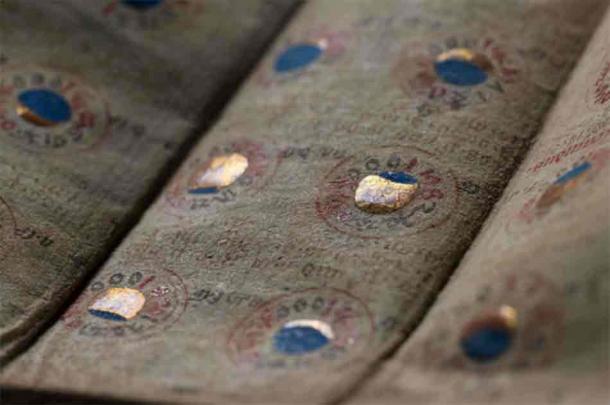
BAT (BOOK) SIGNAL: We know the “bat book almanac” contains detailed illustrations of solar eclipses. But how medical practitioners during the Middle Ages interpreted this information remains unclear. (University of Rochester photo / J. Adam Fenster)
Lunar and solar eclipses were noteworthy in the Middle Ages. But some planetary alignments were the really big thing
In a hierarchy of astronomical importance, what comes first—lunar eclipses, solar eclipses, or planetary alignments or conjunctions?
For medieval people, even though eclipses are much more visible, other planetary conjunctions were much more meaningful. That's because for medieval astrologers and astronomers, the sun and the moon are fundamentally two of the seven planets. And according to Smoller, it's the "slower, outer" planets—Saturn, Jupiter, and Mars—that were considered more significant.
"The really important ones are those special conjunctions of Saturn and Jupiter that occur roughly every 240 and 960 years, definitely not those of the every-20-year variety," she says.
While the next Saturn and Jupiter conjunction will take place in 2040, to medieval astronomers that one wouldn't have been very important. Instead, the next particularly significant planetary conjunction—from a medieval perspective—wouldn't be until the 22nd century.
Either way, if history is any indication, it stands to reason that future denizens of our blue planet will continue humanity's enduring fascination with cosmic happenings.
Top image: University of Rochester illustration based on the miniature of Christine and Sybil from Christine de Pizan’s Collected works (‘The Book of the Queen’). British Library Harley MS 4431, fol 189v. Source: Michael Osadciw/University of Rochester
This article was first published under the title, ‘Surprising facts and beliefs about eclipses from the medieval and Renaissance eras’ by the University of Rochester, New York.















